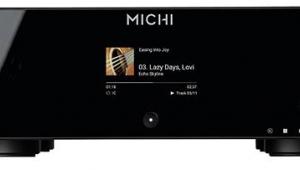Pathos Digit (£1995)
Italian hybrid amplifier specialist Pathos Acoustic unveiled its first CD player last year, the stylish Endorphin top-loader and has now already followed it up with a lower-priced alternative. Now while no-one could mistake the new Digit in its shoebox aspect case for the sci-fi statement of the Endorphin, Pathos says that the two CD players share the same technology inside, with the differences between them limited to the transport mechanism and the power supply.
The Digit is designed to sit alongside the similarly-proportioned Classic One integrated amplifier, itself a more affordable version of the company’s more extended range of high-end valve/solid-state hybrid amplifiers. It’s a cleaner design than the Classic amp, though, without any bright red capacitors or transformer to populate the top board, nor the figured wood frontispiece. In short, the clean lines of the Digit perhaps make it somewhat more ‘timeless’ in its design, not unlike something that would appear from a popular Danish lifestyle brand.
NATURAL BALANCE
Like the Endorphin reviewed in August last year, the Digit includes a pair of small double-triode valves, used in the analogue output stage – this time a couple of ECC88s in place of the Endorphin’s 6H30s. These are said to operate in class A mode with zero feedback, taking the balanced audio output from the single Crystal DAC chip after a simple one-pole constant phase filter. So the XLR balanced outputs are the natural choice for connection here, although Pathos has also included more traditional unbalanced outputs on phono sockets.
A look inside the casework tells an interesting story, for the main circuit board is less than half filled with the components that have obviously been designed to populate it. The Digit is actually a stereo CD player version of a DVD player that Pathos tells us is coming soon. This will use the same layout as the Digit for its front L/R channels, with an extra multichannel codec for surround, centre and sub channels.
In use, the Digit almost behaves like a normal CD player, albeit one that has had all its button labels removed. The ‘almost’ qualification is because, like some home DVD players, the Digit has an annoying habit of switching itself into standby if it’s not used for a few minutes.
So the row of six discreet black buttons that run along the front will control, from left to right, play/pause, stop, skip back, skip forward, standby and open/close. This take a little learning to memorise functions, but some will find the cleaner lines, unblemished by any legends, a worthwhile trade for the sake of aesthetic minimalism. Despite the clear top hatch which shows the loaded disc, and its associated clamp gantry, the Digit is in fact a front-loading CD player. The drawer rolls out – after you’ve found the right button – although not fully, but with just enough clearance to slide a disc in at an angle.
SMOOTH OPERATOR
It’s a foible of the reviewer’s language that ‘smooth’ can be used as an accolade or in a pejorative sense. And at the risk of sounding ambivalent, the Digit is one smooth performer. Considering that the usual complaint with CD sound used to be harshness or edgy treble, this should stand as a virtue, for the Pathos Digit has a very rounded and smoothed treble quality that could not be provoked into excess. Unusually in the realm of CD player voicing, the Digit is actually quite characterful with its seemingly rolled-down top-end.
Playing a brilliant and energetic orchestral work such as Mussorgsky’s Pictures at an Exhibition, [Muti, Philedelphia, EMI747099] the Digit veiled the raspy brass lines in the work’s introduction, while strings homogenised into a more collectivised whole.
Later, cellos and basses were subdued rather than fleshed out with their usual woody, resonant character.
On closer miked studio recordings, the Digit, while still very smooth and civilised, was robbing the leading edge from instruments, subduing the impact of percussion and setting one further back from the recording. It was not that it sounded slow or bloated – it had a certain pace and spryness, and bass was far from overweight or dragging its heels – but it still seemed somewhat veiled. Additionally, I felt there was a dynamic ceiling which the Digit would not exceed. This all gave the player a darkly-lit presentation; soundstage was reasonably wide, just lacking in matching depth, making the ‘viewing’ of sounds at the back of the mix as difficult as if someone had turned down the light dimmers. I also found it less easy to follow timing, as with the 5/4 verse and 12/8 chorus changes in Pentagle’s ‘Light Flight’ [Light Flight, Delta 47 048].
COMMUNICATION BREAKDOWN
From the Simple Acoustic Trio’s debut Habenera, the subtle inflections of drum and cymbalwork, the plucking of upright bass notes, the upper partial’s of the piano’s sonorous tone; these were all lost in the Digit’s romantically shrouded presentation. With a variety of test pieces I couldn’t escape from the Digit’s underdeveloped sense of communication. For all its smoothness and edge-free presentation, I found myself shortchanged of real musical interest. So while the Digit steers a wide road around the pitfalls of ‘showroom tuning’ – you would never accuse this player of blinding you with detail – it also failed to engage this listener with the constituent parts of a musical work to hold attention for very long.
VERDICT
This stylish and beautifully-crafted minimalist design of a CD player has a smooth and inoffensive character that may gloss over most of the unwanted edge of CD sound. Unfortunately, some will find this papering of the cracks too effective, leading to an overly restrained presentation that can fail to carry the emotion of a musical performance.
Originally published in the January 2008 issue

























































